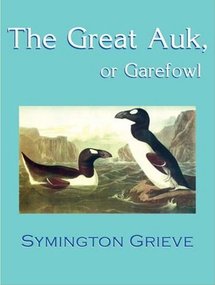Reviewed by Grant McCreary on June 22nd, 2007.
Upon arriving at the Denver International Airport on a recent trip a couple of large murals on the walls greatly surprised me. I now wish that I had paid more attention to them (the allure of seeing new birds propelled me quickly through the terminal), but they were paintings that seemed to celebrate biodiversity and warned us that the extinctions of the past still threaten species today. I distinctly remember two species depicted. The Resplendent Quetzal was shown as an example of a currently threatened species. This bird is possibly the one that I most want to see in the world, thus it’s no shock that I noticed it. Of course, as its name suggests, it truly is resplendent and quite hard to miss. The other bird I noticed doesn’t look anything like the quetzal. It is plainly colored in black and white, and although very different looking, not something that would stand out. As the most prominent example of a species whose fate we want the quetzal to avoid the mural showed a Great Auk.
I would wager that most beginning birders, perhaps given a little time, will come to learn of the Passenger Pigeon. They may hear about the great flocks of the bird that darkened the sky for hours. But what about the Great Auk? I daresay much fewer are familiar with this bird. And it seems this has always been the case. The author of this work sought to rectify that situation over a century ago. He presents here the sum of knowledge that was then available about this strange, but magnificent, creature.
The Great Auk is the largest known member of its family. It was sometimes known as “the Penguin”, and like that unrelated family it too had become flightless. Unfortunately, that trait helped speed along the rapid demise of the bird. Sailors along the Atlantic quickly realized that this bird was easy to catch and quite tasty. They would take great quantities of the birds from breeding colonies as food for long voyages. The rampant slaughter, along with the species’ slow reproductive rates, doomed it to extinction. The last known of its kind, a pair of birds, were killed June 3, 1844 on an island off of Iceland.
This book was written in 1885, 41 years after the bird’s extinction, and many more years after the bird was common. The author scoured all the available material that had been printed about the auk and also corresponded with those who had seen it. He was therefore able to assemble a basic life history of the bird. Basic information about the breeding, feeding, and other habits is presented. However, there were some large gaps in the knowledge of the species at the time. For instance, the auks spent the 10 months when not breeding at sea, but no one knew where. Surprisingly, from what I understand, little more is known about these enigmatic birds now than it was when this book was published.
The one-time range of the bird is given in both the text and a map. The map in this edition has been reprinted in black and white and with no reformatting. It is therefore a little difficult to interpret, but the range can be made out. Thankfully, a color map has been made available in pdf format on the publisher’s website, and it looks much better.
The majority of the book describes the existing remains of these birds along with where and how they were discovered. Bones and even mummified remains have been found in North America and Europe. Some of these appeared to have died of natural causes, but most of the bones are from birds that have been killed by man. Some bones have been found in some very ancient middens (refuse heaps), showing that mankind had been taking advantage of the resources provided by this bird for quite some time. The amount of space dedicated to this topic was a great surprise to me. There are even remarks about the value of skins, and how much they have been sold for. While this was strange and novel at first it soon got repetitive. I would imagine that casual readers would not be very interested in these details. But for those whose research or interests leans in this direction it is a virtual treasure trove of information.
The writing of the author is clear and easy to understand. The writing style is slightly different than is common today, but to me it just made the reading more enjoyable. The author, however, does quote some older sources and these can be more difficult to understand due to differences in language and grammar.
Those with a casual interest in this bird would probably be
better off reading a more modern treatment, such as the one
contained within Hope Is the Thing with Feathers by
Christopher Cokinos (which is very highly recommended). But
this monograph is absolutely necessary for anyone who wants
to know everything about this bird, or who just wants to experience
it through a source closer in time to the bird itself.
The volume reviewed has been published by Coachwhip Publications, and is a reprint of the original work. You can order this book, along with other long-out-of-print natural history titles, on their website.
Disclosure: I get a small commission for purchases made through links in this post.
Disclosure: The item reviewed here was a complementary review copy provided by the publisher. But the opinion expressed here is my own, it has not been influenced in any way.



[…] Great auk: here. […]